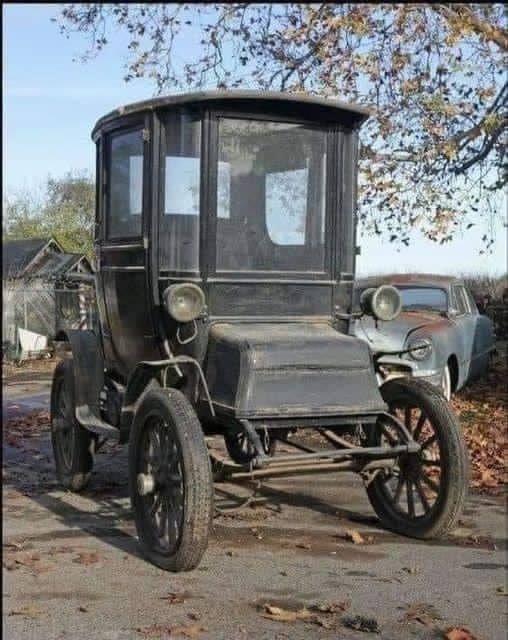The Detroit Electric Model D was an impressive feat for its time. Manufactured by the Anderson Electric Car Company in Detroit, Michigan, it was one of the early successes in electric vehicle (EV) technology. Introduced in 1910, the Model D had a range of approximately 100 miles on a single charge, remarkable given the battery technology of the era. It reached a top speed of 25 mph, competitive with many gasoline-powered cars of the time.

Design and Construction
The Model D featured a sleek, elegant design typical of luxury cars of its era. It was equipped with a rechargeable lead-acid battery pack powering an electric motor at the rear. The chassis was made of wood with steel reinforcements for added strength.
Performance and Range
With a range of approximately 100 miles on a single charge, the Model D was well-suited for city driving and short trips. Its top speed of 25 mph was adequate for urban and suburban travel, though it would have been outpaced by faster gasoline-powered cars on open roads.
Popularity and Market
The Detroit Electric brand appealed to affluent urban consumers who valued its quiet operation, ease of use, and lack of emissions. Famous personalities such as Thomas Edison, Clara Ford (wife of Henry Ford), and John D. Rockefeller Jr. owned Detroit Electric vehicles. The brand gained popularity, especially among women, due to its ease of operation and lack of noise, odor, and vibration associated with gasoline-powered cars.
Production and Decline
The Anderson Electric Car Company produced Detroit electric vehicles from 1907 to 1939. However, the rise of inexpensive gasoline-powered automobiles, improvements in internal combustion engine technology, and the availability of paved roads contributed to the decline of electric cars by the 1930s.
Legacy
Despite their decline in the early 20th century, electric vehicles experienced a resurgence of interest in the late 20th and early 21st centuries. Concerns about air pollution, climate change, and fossil fuel depletion drove this renewed interest. The pioneering efforts of companies like Detroit Electric laid the foundation for modern electric cars.
Advantages of Electric Cars
The Detroit Electric Model D had several advantages over gasoline-powered cars. These included smoother operation, simpler maintenance (no need for oil changes or fueling up at gas stations), and easier starting in cold weather, as electric motors don’t rely on combustion.
Charging Infrastructure
Charging infrastructure for electric vehicles in the early 20th century was quite different from today. Owners typically charged their cars at home using stations connected to the electrical grid. Some cities also had public charging stations, although they were less common than gas stations.
Battery Technology
Early electric cars like the Model D used lead-acid batteries, which were heavy, had limited energy density, and required regular maintenance, such as topping up with distilled water. These batteries were relatively primitive compared to today’s lithium-ion batteries.
Limited Market Segment
While electric cars like the Model D had their advantages, they were limited to a niche market of affluent consumers. Their high cost, limited range, and the convenience of gasoline-powered cars meant that they never achieved widespread adoption until much later.
Environmental Considerations
Electric vehicles were cleaner in terms of emissions compared to early gasoline cars. However, electricity generation at the time often relied on coal-fired power plants, producing pollution and greenhouse gas emissions. Despite this, electric vehicles had the potential to reduce local air pollution in cities, where gasoline cars were a significant source of smog-forming pollutants.
Customization and Luxury
The Detroit Electric Model D was often highly customizable. Customers could choose from various body styles, interior materials, and optional features, making each car somewhat unique. These vehicles were considered luxury cars, featuring high-quality craftsmanship and luxurious appointments.
Innovations in Electric Vehicle Technology
The early 20th century saw significant innovation in electric vehicle technology. Engineers and inventors continually experimented with new battery chemicals, motor designs, and charging systems to improve performance and usability. These innovations laid the groundwork for future advancements in electric vehicle technology.
Commercial and Industrial Use
Electric cars like the Model D found applications in commercial and industrial settings. Electric trucks, delivery vehicles, and even buses were used in some cities for local transportation and delivery services. These vehicles benefited from the same advantages of electric propulsion, including quiet operation and zero tailpipe emissions.
Cultural and Social Impact
Electric vehicles of the early 20th century symbolized technological progress and embodied broader cultural and social ideals. For example, electric cars were often associated with the suffragette movement, as they provided women with independent transportation at a time when driving was still unconventional for women.
Endurance and Reliability
Despite the limitations of early battery technology, electric vehicles like the Model D were known for their endurance and reliability. Electric motors have fewer moving parts than internal combustion engines, leading to fewer mechanical failures and less maintenance. Some owners of electric cars from this era reported many years of trouble-free operation.
Marketing and Advertising
Companies like the Anderson Electric Car Company used various marketing strategies to promote electric vehicles. Advertisements emphasized the convenience and cleanliness of electric cars, portraying them as modern and sophisticated alternatives to gasoline-powered vehicles. Some ads targeted specific demographics, such as women and urban dwellers, highlighting the ease of operation and lack of exhaust fumes.
Range Anxiety and Charging Challenges
While the Detroit Electric Model D offered a respectable range for its time, drivers still faced challenges related to range anxiety and charging infrastructure. Long-distance travel required careful planning and access to charging facilities along the route. The limited range of early electric vehicles meant they were primarily used for short-distance urban travel.
Celebrity Endorsements
The popularity of electric vehicles in the early 20th century was bolstered by endorsements from celebrities and prominent figures. Wealthy individuals, including actors, industrialists, and politicians, often owned electric cars and publicly endorsed their benefits. These endorsements helped elevate the status of electric vehicles and increase their visibility in popular culture.
Global Influence
The influence of electric vehicles extended beyond the United States. Manufacturers in Europe and other parts of the world produced their own electric car models. Companies in France, England, and Germany developed electric vehicles for local markets, each with unique designs and features. This global interest in electric transportation highlights the widespread recognition of electric vehicles as a viable alternative to gasoline-powered cars.
The Detroit Electric Model D stands as a testament to early innovation in electric vehicle technology. Its remarkable range, ease of use, and quiet operation made it a standout choice for affluent consumers of the early 20th century. Though overshadowed by gasoline-powered cars for much of the 20th century, the legacy of the Model D and its contemporaries laid the groundwork for the electric vehicle revolution we are witnessing today. The Model D reminds us that the journey to sustainable transportation began over a century ago, paving the way for the advancements we see in modern electric vehicles.





